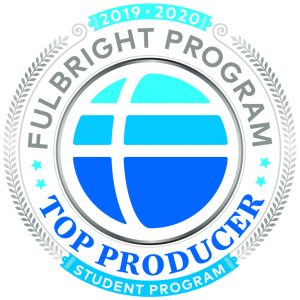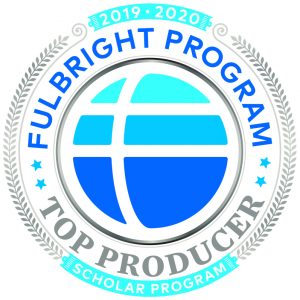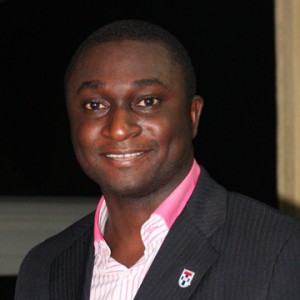

What makes a “Fulbright Top-Producing Institution“? In the coming weeks, a variety of institutions will discuss their efforts to recruit, mentor, and encourage students and scholars to apply for the Fulbright U.S. Student and U.S. Scholar Programs. We hope these conversations pull back the curtain on the advising process, and provide potential applicants and university staff with the tools they need to start their Fulbright journey.
By Joanie Andruss, assistant director, Nationally Competitive Scholarships at Appalachian State University
Question: Your outstanding students are one of many factors that led to this achievement. What makes your students such exceptional candidates for the Fulbright Program?
I’ve found that our students tend to seek out diverse combinations of academic, service, and leadership activities, which contribute to what makes them such exceptional candidates for the Fulbright Program. Caroline Webb, an English Teaching Assistant in Timor-Leste, embodies this. She majored in psychology, had a passion for American Sign Language, was highly involved in campus as a Student Leadership Consultant, collaborated with faculty on research, studied abroad, was a teaching assistant, played a range of Appalachian instruments, and was a member of an interdisciplinary living-learning community known as the Watauga Residential College. This list of noteworthy accomplishments isn’t unique only to Caroline, but represents the range of involvement that many of our students engage with on our campus.
What steps have you taken to promote a Fulbright culture on your campus?
Our campus’s involvement with the Fulbright Program includes sending U.S. Students, Scholars, and Teacher Exchange participants, as well as hosting visiting Scholars-In-Residence. In late 2017, a group of faculty, staff, and administrators convened to form a Fulbright Week planning committee. This first group set the tone for the following years, and Fulbright Week events have become a regular part of campus programming each spring. During our Fulbright Week, we host receptions celebrating past and prospective Fulbright Scholars and Students, and offer a series of programming and advising for applicants. This serves as a kick-off event for continued support throughout the application cycle and year for faculty, staff, and students.
Efforts in promoting a Fulbright culture on our campus have also been enhanced through involvement in the 2018–19 Fulbright Program Advisor Development Initiative. This two-part training provided an in-depth opportunity to develop a more nuanced understanding of the Fulbright U.S. Student Program, further engage faculty, staff, and students across the multiple Program options, and offered additional opportunities to engage with Fulbright on our campus through outreach visits and faculty referrals to serve on National Screening Committee panels.
How has your institution benefited from increased engagement with the Fulbright Program?
Appalachian State University has had a successful history of engagement with the Fulbright U.S. Scholar Program, being named a top producer in that category four times since 2010. Appalachian encourages and supports its faculty members in applying for Fulbright awards because the university’s leadership recognizes the benefits of the program. This engagement provides faculty the opportunity to share academic knowledge with colleagues and students in other countries and to bring new knowledge, global understanding, and connections back to our campus community.
More recently, our institution recognized the need to further support students in their own pursuits of nationally competitive awards. This resulted in the creation of the Office of Nationally Competitive Scholarships, which offers outreach, mentorship, and advising throughout the entire application and selection process for a range of competitive awards, including the Fulbright U.S. Student Program. Within the first Fulbright application cycle after the creation of the office, we had four finalists, with three ultimately accepting the award for the 2019–20 grant year. This earned us the distinction of Top Producing Institution for Fulbright Student Programs.
From the student and applicant perspective, the process of applying for Fulbright U.S. Student awards has also had a significant impact on their connection with our institution and their preparation for their futures after graduation. A current Fulbright semi-finalist described that going through the application process gave her “even further appreciation for and faith in my alma mater.”
What advice do you have for other universities and colleges that want to increase the number of Fulbrighters produced by their institution?
My advice might be most relevant for universities and colleges with a small number of previous Fulbright U.S. Student recipients. These institutions therefore have limited examples of successful peers. Prior to the 2019–20 Fulbright year, only five Appalachian students had received a Fulbright award during the program’s history. So one of my challenges starting out was to encourage students to redefine what they thought Fulbright was and who it was for. I sought students who might not normally attend an information session, but could be great candidates for Fulbright if only they could start envisioning the program as a possible opportunity. I also worked to correct misperceptions of why we had so few prior recipients — not because our students weren’t competitive, but because they weren’t aware of the opportunities or didn’t have history with the award that other campuses might have. I tried to help applicants envision themselves as being part of a cohort that could change that reality and provide an inspiring model to those that would come after them.
Some concrete approaches include:
• Establishing an on-campus review process with earlier pre-application elements, such as a low stakes intent to apply “deadline” or first draft “deadline” that encouraged prospective applicants to move through each of the stages in smaller, more manageable pieces.
• Tracking students that either had indicated some initial interest in Fulbright or who had worked with me on other awards, such as the Gilman International Scholarship, and then targeting them specifically, saying I thought they could be a good candidate for Fulbright.
• Helping students examine which particular Fulbright award was the right fit for the right reasons.
• Developing an on-campus review process that emphasized a supportive experience for students with a diverse committee of faculty and staff, many of whom were prior Fulbright alumni themselves or perhaps future Fulbright U.S. Scholar applicants.
• Conducting post-application assessments to measure students’ perspectives on how the process impacted key learning outcomes, then communicating those outcomes to the next round of prospective applicants: “Yes, Fulbright is competitive, but this will be a valuable process regardless of the outcome.”
We now find ourselves being recognized as a Top Producing Institution for the Fulbright U.S. Student Program. I attribute the work focusing on developing student self-efficacy in tandem with tangible advising practices and application procedures to have made a lasting impact. This all happened within a context of support from university leadership, a Nationally Competitive Scholarship Advisory Board, and an enthusiastic and engaged group of faculty, staff, and students campus-wide.



